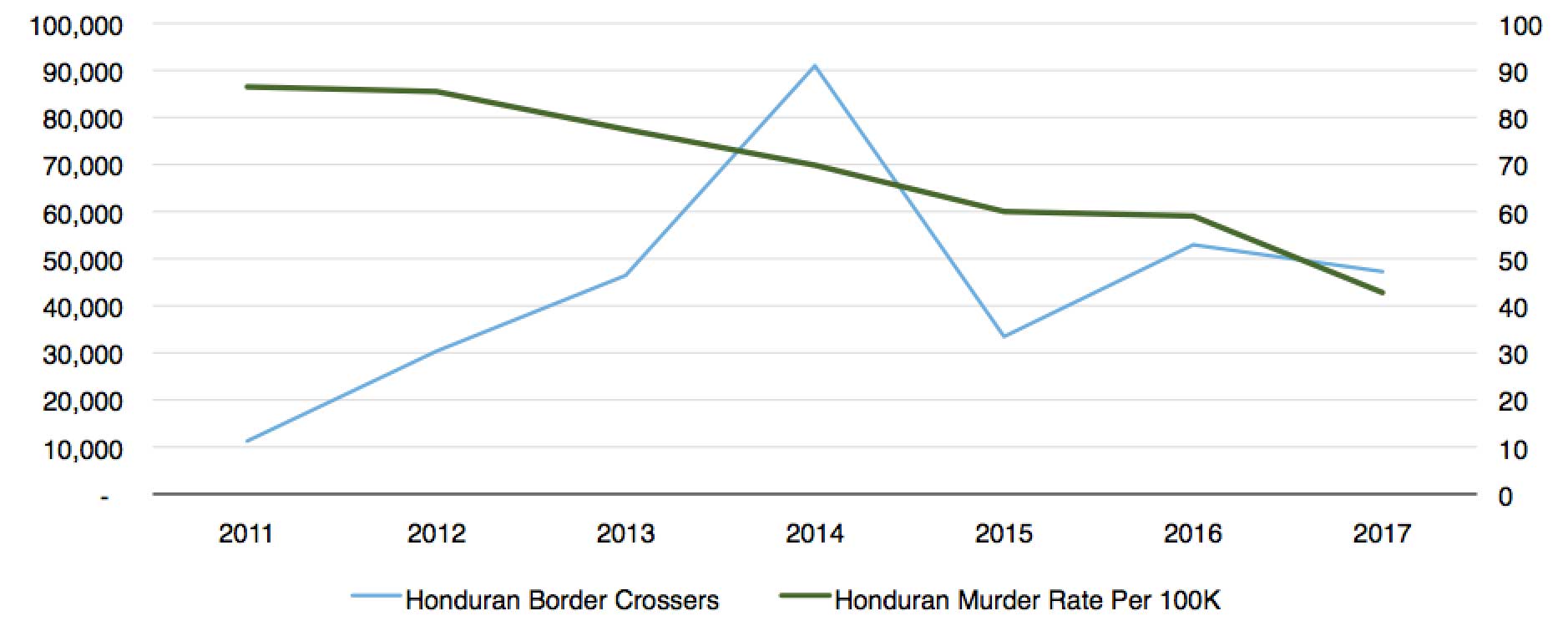One of the most common arguments from advocacy groups with regard to the influx of Central American migrants is that these migrants are fleeing violence. Groups such as the ACLU and SPLC cite "gang brutality", "gang violence", and fear of murder as reasons why the number of illegal, border-crossing migrants from the Northern Triangle (Honduras, Guatemala, and El Salvador) has soared in recent years.
As such, one might expect that, as the murder rate rises in those countries, the number of border-crossers would correspondingly go up, and vice versa. But the data show no obvious relationship between Central American homicide rates and the number of Central Americans apprehended illegally crossing our border in a year.
Figure 1. Honduran Annual Illegal Border-Crossers vs. Homicide Rate |
 |
|
Sources: Customs and Border Protection, Associacion para una Socieded Mas Justa. |
In Honduras, murder rates have fallen by over half since 2011 — from 86.5 per 100,000 to 42.8 per 100,000 in 2017. During that same time, the annual number of apprehensions of Hondurans at the U.S.-Mexico border quadrupled, albeit with fluctuations.
Figure 2. Guatemalan Annual Illegal Border-Crossers vs. Homicide Rate |
 |
|
Sources: Customs and Border Protection, Guatemala Ministry of Government. |
Guatemala saw a very similar trend, with murder rates falling from 38.6 per 100,000 to 19.0 per 100,000 between 2011 and 2017. At the same time, the annual number of Guatemalan apprehensions more than tripled — from approximately 18,000 to 66,000.
Figure 3. Salvadoran Annual Illegal Border-Crossers vs. Homicide Rate |
 |
|
Sources: Customs and Border Protection, International Crisis Group, National Police of El Salvador. |
El Salvador's murder rate has seen large annual year-to-year swings, as low as 40 per 100,000 in 2013 and then more than doubling to over 100 per 100,000 in 2015. Meanwhile, the number of Salvadoran border apprehensions has risen dramatically, peaking in 2016.
There are a range of push-and-pull factors responsible for migration, and for some migrants fleeing violence may well be a legitimate factor.
But as far as push factors go, economics is likely more important than fleeing violence. According to a government poll of Guatemalans, 91 percent are migrating to the United States for economic reasons, and fewer than 1 percent say they are fleeing gangs or violence.
As for the pull factors, loopholes in our asylum laws create strong incentives for migrants to come to the United States — especially with their families. The Flores settlement agreement, for example, requires that minors be released from detention after 20 days. Credible fear standards ensure that aliens can simply tell asylum officers that they fear persecution in their home countries in order to avoid deportation. And the Trafficking Victims Protection Reauthorization Act of 2008 (TVPRA) ensures that unaccompanied children from Central America are transferred to HHS custody within 72 hours.
Despite what advocacy groups will tell you, these cracks in our asylum laws create far stronger incentives for Central Americans to travel to our southern border than fear of violence.
